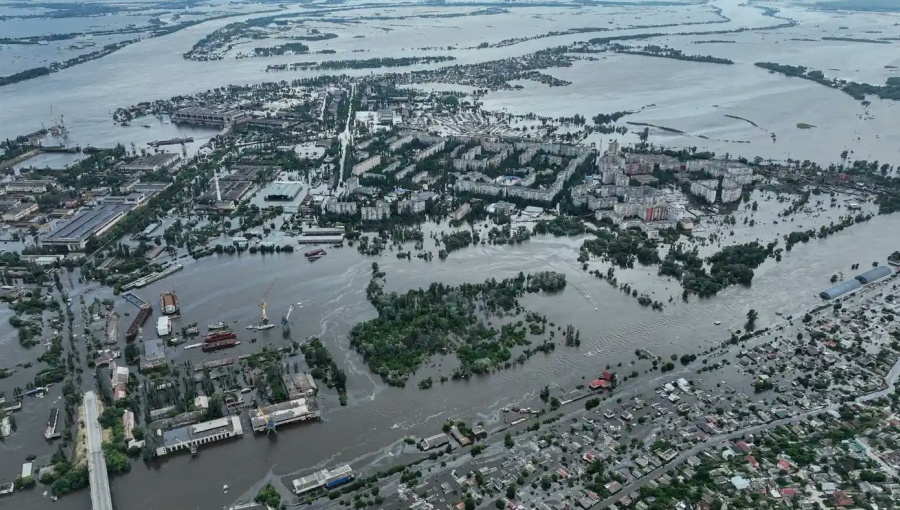ICC launches investigation into Kakhovka dam destruction

The International Criminal Court (ICC) has launched an investigation into the destruction of the Kakhovka dam, as the crisis leaves 700,000 people with limited access to drinking water and causes billions in damage, Ukrainian President Volodymyr Zelenskiy said on June 11.
Representatives from the ICC visited the Kherson region where 46 settlements remain flooded, the Kyiv Independent reported. Water levels are dropping, down from 5.5 metres to 4 metres over the weekend, but the evacuation process is ongoing as houses, ecosystems and businesses have all been destroyed. 2,718 have been evacuated from Kherson Oblast and 982 from Mykolaiv Oblast, as of June 11.
Kyiv, which accuses Russia of deliberately blowing up the Kakhovka dam, says it is cooperating with the ICC, providing full access to the impacted areas, witnesses and evidence. The EU has backed Ukraine’s accusations that Russia is behind the attack.
“This investigation is very important for the security of the whole world,” Zelenskiy said.
Already damages amount to UAH55bn ($1.5bn) but could rise to $10bn over the next five years as agricultural losses are expected to be massive, according to Ruslan Strilets, Minister of Environmental Protection, Ukraine Business News reported. Irrigation systems across southern Ukraine are without a water source and won't be restored for at least three to seven years, threatening 1-1.5mn hectares of farmland and the region’s agricultural sector.
The hardest hit region is Kherson, with 94% of its irrigation systems without a water source, followed by 74% in Zaporizhzhia and 30% in Dnipropetrovsk. Fields could turn into deserts as early as next year, warned the Ministry of Agrarian Policy and Food.
Kherson’s iconic watermelon fields have been decimated, according to Anton Gerashchenko, advisor to the Minister of Internal Affairs of Ukraine. The delivery of watermelons floating in the canal signalled the start of Ukraine’s summer, but the current crop has been completely washed away.
Agriculture is a major source of income for southern Ukraine, with Kherson growing vegetables, cereals and oil crops. The flooding has devastated granaries, which will subsequently lead to higher grain prices across the globe.
"The ability of that part of Ukraine to grow the grain on which the world depends will be significantly reduced. This will mean fewer grain exports to the global south, and higher grain prices around the world,” Martin Griffiths, UN Under-Secretary-General for Humanitarian Affairs, said in an interview with the Associated Press.
The Ukrainian government and the international community have rallied together to provide emergency aid to the affected regions, including equipment to dissipate the flooding and clean water. Currently, an estimated 700,000 people are hindered from accessing drinking water, with a precarious situation regarding fresh water supply in occupied Crimea.
The National Resistance Centre, created by the Special Operations Forces of the Armed Forces of Ukraine, reports that Russia does not have a clear plan to restore the water supply to Crimea and is keeping the crisis under wraps to avoid widespread panic on the peninsula. The Centre believes this could weaken Russia’s ability to control Crimea.
Southern Ukraine’s renewable energy sector will also be impacted by the catastrophe. The destruction of the Kakhovka hydroelectric power plant (HPP) will remove 334 MW of capacity from Ukraine’s energy grid and the damage caused to solar power plants will remove over 150 MW. Ukraine has plans to build a new HPP on the same site once the area is liberated, but it will take five years and will cost between €1-2bn.
Although the Kakhovka HPP hasn’t provided electricity to Ukraine since it was occupied in the early days of the invasion, other HPPs will be affected by the change in water level, destabilising Ukraine’s power system. As such, the EU will increase electricity export capacity to Ukraine to 2 GW, up from the current capacity of 1.4 GW, following an emergency meeting of the International High-Level Advisory Council under the Ministry of Energy last week.
The flooding has killed at least 10 people with 42 still missing and Russia continues to strike the region increasing the death toll, despite the humanitarian crisis. A shell killed a 32-year-old pregnant woman as she attempted to evacuate her grandparents from the occupied town of Hola Prystan.
Labelling the catastrophe a “terrorist act” by Moscow, Ukraine has called for a new round of sanctions targeting Russia’s missile and nuclear industries.


Follow us online